Richard Ingersoll Updates Landmark Study Of the American Teaching Force, Now Covering 3 Decades

The past three decades have transformed America's teacher workforce. Penn GSE’s Richard Ingersoll looks at who’s teaching, for how long, and what it means for the nation's students and taxpayers.
Kat Stein
Executive Director of Communications
(215) 898-9642
Jeff Frantz
Associate Director of Communications
(215) 898-3269
*Note for TV and radio: The University of Pennsylvania has an on-campus ISDN line and ready access to a satellite uplink facility with live-shot capability.
Schools are hiring more teachers than ever, but the profession remains unstable.
From statewide strikes to pension crises to understaffed schools, working conditions for America’s teachers are a flashpoint in public debate. Now Richard Ingersoll, of the University of Pennsylvania Graduate School of Education, is updating his longitudinal study on the elementary and secondary teaching force to tell us more about how the teaching force has been transformed over the last 30 years.
In this new edition of Seven Trends: The Transformation of the Teaching Force, Ingersoll finds that America’s schools are hiring more teachers than ever but struggle to keep them in the profession. He shows that students are more likely to have teachers who are beginners, and that those teachers are more likely to be women and minorities. And above all, Ingersoll describes an unstable profession that raises real questions about how well the nation’s school systems function.
“The teacher workforce has been transformed over the last 30 years, with significant financial, structural, and educational consequences,” Ingersoll said. “Too often researchers, school leaders, and policymakers are still operating under false assumptions about who goes into teaching and how teaching careers unfold. If we want to improve student performance, we must understand this new reality.”
Find the full report, animation, and infographic here
Among Ingersoll’s key findings:
- A LEAP IN NUMBERS — Between 1987-88 and 2015-16, the number of teachers in public, private, and charter schools increased by more than three times the rate of student enrollment increases. This increase is tied, in large part, to reforms that the public has demanded: smaller elementary school class sizes, more math and science teachers, more special education teachers, more enrichment teachers in elementary schools, more reading teachers, and more English as a Second Language (ESL) and bilingual teachers.
- LEAVING IN HIGH NUMBERS — 44 percent of new teachers leave within five years.
- A YOUNGER TEACHING FORCE — Public school teachers have gotten younger. In 2007-08, the modal or most common teacher was 55 years old. In 2015-16, the modal age ranged from mid-30s to mid-40s.
- DECLINE IN EXPERIENCE — The modal teacher has one to three years of experience, a sharp decline from the 15 years of experience the modal teacher had in 1987-88.
- FEWER MEN THAN EVER — Over 76 percent of public school teachers are women, high even for a profession that has been historically female dominated.
- MINORITIES BEING CHURNED OUT — While there remains a parity gap (51 percent of public school students are minorities, and only 19.9 percent of their teachers are), there has been a dramatic surge in minority teacher hires. But these same teachers are among the most likely to leave the profession.
- INSTABILITY CONCENTRATED — About half of all teacher turnover takes place in 25 percent of public schools. High-poverty, high-minority, urban, and rural public schools have among the highest rates of turnover.
These findings have major implications for one of America’s largest professions and the future of public education. Among the questions Ingersoll raises:
- Will the teaching workforce continue to outgrow the student population? If so, how will cash-strapped schools pay for it? So far, teacher turnover has actually worked in favor of property-tax payers, given that early-career teachers typically earn less money and teachers leaving the profession after a few years do not take large pension payouts. It’s not clear if this unintended outcome can last.
- A disproportionate number of minority teachers work in under-resourced schools with heavily minority student populations. Perhaps it’s not surprising they burn out at higher rates. What supports do they need to stay in the classroom?
- In an increasing number of schools, boys will go from kindergarten through high school encountering few, if any, male teachers. How will that affect them?
- Research has consistently shown that a teacher’s ability to improve student performance grows as they gain experience, especially in their first five years on the job. What changes — in pay, working conditions, or something else — could keep teachers in the classroom longer? Or, if this turnover continues, what programs could keep students from missing out?
Penn GSE is one of the nation’s premier research education schools. No other education school enjoys a university environment as supportive of practical knowledge-building as the Ivy League’s University of Pennsylvania. The School is notably entrepreneurial, launching innovative degree programs for practicing professionals and unique partnerships with local educators, and the first-ever business plan competition devoted exclusively to educational products and programs. For further information about Penn GSE, please visit www.gse.upenn.edu/
